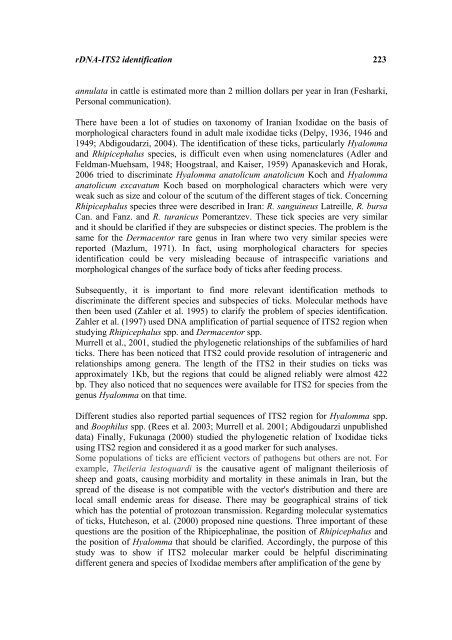rDNA-ITS2 Identification of Hyalomma, Rhipicephalus ... - HIKARI Ltd
rDNA-ITS2 Identification of Hyalomma, Rhipicephalus ... - HIKARI Ltd
rDNA-ITS2 Identification of Hyalomma, Rhipicephalus ... - HIKARI Ltd
You also want an ePaper? Increase the reach of your titles
YUMPU automatically turns print PDFs into web optimized ePapers that Google loves.
DNA-<strong>ITS2</strong> identification 223<br />
annulata in cattle is estimated more than 2 million dollars per year in Iran (Fesharki,<br />
Personal communication).<br />
There have been a lot <strong>of</strong> studies on taxonomy <strong>of</strong> Iranian Ixodidae on the basis <strong>of</strong><br />
morphological characters found in adult male ixodidae ticks (Delpy, 1936, 1946 and<br />
1949; Abdigoudarzi, 2004). The identification <strong>of</strong> these ticks, particularly <strong>Hyalomma</strong><br />
and <strong>Rhipicephalus</strong> species, is difficult even when using nomenclatures (Adler and<br />
Feldman-Muehsam, 1948; Hoogstraal, and Kaiser, 1959) Apanaskevich and Horak,<br />
2006 tried to discriminate <strong>Hyalomma</strong> anatolicum anatolicum Koch and <strong>Hyalomma</strong><br />
anatolicum excavatum Koch based on morphological characters which were very<br />
weak such as size and colour <strong>of</strong> the scutum <strong>of</strong> the different stages <strong>of</strong> tick. Concerning<br />
<strong>Rhipicephalus</strong> species three were described in Iran: R. sanguineus Latreille, R. bursa<br />
Can. and Fanz. and R. turanicus Pomerantzev. These tick species are very similar<br />
and it should be clarified if they are subspecies or distinct species. The problem is the<br />
same for the Dermacentor rare genus in Iran where two very similar species were<br />
reported (Mazlum, 1971). In fact, using morphological characters for species<br />
identification could be very misleading because <strong>of</strong> intraspecific variations and<br />
morphological changes <strong>of</strong> the surface body <strong>of</strong> ticks after feeding process.<br />
Subsequently, it is important to find more relevant identification methods to<br />
discriminate the different species and subspecies <strong>of</strong> ticks. Molecular methods have<br />
then been used (Zahler et al. 1995) to clarify the problem <strong>of</strong> species identification.<br />
Zahler et al. (1997) used DNA amplification <strong>of</strong> partial sequence <strong>of</strong> <strong>ITS2</strong> region when<br />
studying <strong>Rhipicephalus</strong> spp. and Dermacentor spp.<br />
Murrell et al., 2001, studied the phylogenetic relationships <strong>of</strong> the subfamilies <strong>of</strong> hard<br />
ticks. There has been noticed that <strong>ITS2</strong> could provide resolution <strong>of</strong> intrageneric and<br />
relationships among genera. The length <strong>of</strong> the <strong>ITS2</strong> in their studies on ticks was<br />
approximately 1Kb, but the regions that could be aligned reliably were almost 422<br />
bp. They also noticed that no sequences were available for <strong>ITS2</strong> for species from the<br />
genus <strong>Hyalomma</strong> on that time.<br />
Different studies also reported partial sequences <strong>of</strong> <strong>ITS2</strong> region for <strong>Hyalomma</strong> spp.<br />
and Boophilus spp. (Rees et al. 2003; Murrell et al. 2001; Abdigoudarzi unpublished<br />
data) Finally, Fukunaga (2000) studied the phylogenetic relation <strong>of</strong> Ixodidae ticks<br />
using <strong>ITS2</strong> region and considered it as a good marker for such analyses.<br />
Some populations <strong>of</strong> ticks are efficient vectors <strong>of</strong> pathogens but others are not. For<br />
example, Theileria lestoquardi is the causative agent <strong>of</strong> malignant theileriosis <strong>of</strong><br />
sheep and goats, causing morbidity and mortality in these animals in Iran, but the<br />
spread <strong>of</strong> the disease is not compatible with the vector's distribution and there are<br />
local small endemic areas for disease. There may be geographical strains <strong>of</strong> tick<br />
which has the potential <strong>of</strong> protozoan transmission. Regarding molecular systematics<br />
<strong>of</strong> ticks, Hutcheson, et al. (2000) proposed nine questions. Three important <strong>of</strong> these<br />
questions are the position <strong>of</strong> the Rhipicephalinae, the position <strong>of</strong> <strong>Rhipicephalus</strong> and<br />
the position <strong>of</strong> <strong>Hyalomma</strong> that should be clarified. Accordingly, the purpose <strong>of</strong> this<br />
study was to show if <strong>ITS2</strong> molecular marker could be helpful discriminating<br />
different genera and species <strong>of</strong> Ixodidae members after amplification <strong>of</strong> the gene by
















